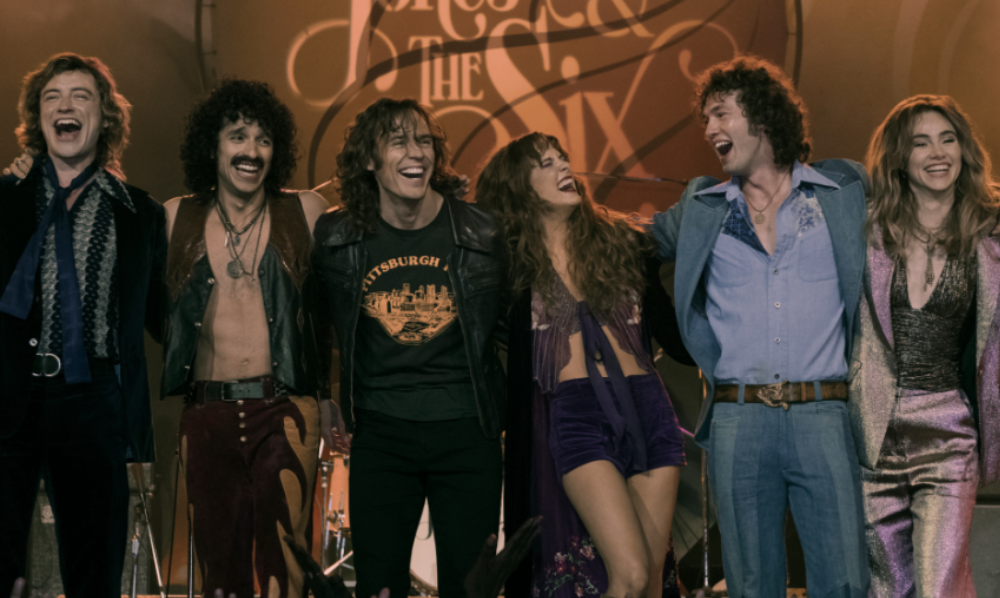Spoilers ahead for Daisy Jones & The Six
Daisy Jones & The Six is Prime’s latest hit novel adaptation. Based on the sex, drugs, and rock & roll filled 70s, the show adapts the book’s documentary interview format with added flashbacks that would not have been accessible otherwise in written form. Loosely based on the iconic band Fleetwood Mac, author Taylor Jenkins Reid took inspiration from the turbulent relationship between performers Stevie Nicks and Lindsay Buckingham. Much like Fleetwood Mac, “Daisy Jones & The Six” creates a captivating narrative that echoes the dynamics, trials, and triumphs of real-life rock bands. The show employs a similar storytelling approach to true documentaries of the 70s: presenting interviews, anecdotes, and accounts from different characters involved in the band’s journey. A captivating story, the show explores a band trying to make it in the rock industry while balancing their tumultuous relationships and substance abuse issues.
Riley Keough plays lead singer Daisy Jones, and does not disappoint with her powerful vocals and quirky charm. In contrast, while Sam Claflin is a talented actor with a great voice, he doesn’t entirely achieve the “it factor” or charisma of the book’s Billy Dunne, and looks far older than his character’s technical age. The chemistry between the cast is genuine and engaging, with Karen (Suki Waterhouse), and Camila (Camila Morrone) standing out in their supporting roles. Moreover, both Graham (Will Harrison) and Eddie (Josh Whitehouse) are both made more likable than their aggravating book counterparts through the charm of their characters. Furthermore, the changes made to the book also ensure that the book’s fans remain happy due to the show’s loyalty to the source material, while still being surprised along the way with new twists and additions. The writers also highlight Daisy’s best friend Simone Jackson (Nabiyah Be) as an explicitly queer character, which was not explored in Reid’s novel. Her relationship with the newly created character Bernie (Ayesha Harris) is a more intractable one as the show explores what it meant to be a Black, Queer musician in the 70s.
While often lighthearted, the show probes heavier themes as well, emphasizing both Billy and Daisy’s addictions. The most impressive aspect of Sam Claflin’s performance is his struggle with substance abuse issues, especially when balancing fatherhood and touring. Unfortunately, much of his strife with addiction gets swept under the rug to make room for other scenes related to the band’s music. In contrast, the show fails to capture the more serious effects of Daisy’s addiction from the book, accrediting much of her quirk and personality to her usage. Despite this, the show does portray Billy and Daisy as kindred spirits, and scenes centered around their shared struggles are some of the most genuine in the show.
However, this authenticity has its limits. Daisy Jones & the Six falls short in creating romantic relationships that make viewers root for them. While Billy and Daisy’s “forbidden” romance should make the audience long for them even more, their chemistry is not as compelling as one would hope. In the novel, the pair never acted on their feelings, demonstrating that they were too similar to be together. In contrast, the show allows them to act on their passions, which elucidates the problematic nature of the pair. While exciting the viewer, this change makes one feel awful for Billy’s wife and longtime supporter, Camila, whose tragic story is amplified when broadcasted onscreen. Moreover, bandmates Karen and Graham initially seem like an opposites attract slow-burn, but it becomes clear throughout both the show and the book that their feelings for each other never quite align—making it impossible for them to have a compatible relationship. Even with these shortcomings, many fans still root for these couples, generating mixed reviews on the romantic aspects of the show.
While the style and set design retain accuracy for the time period, the show lacks conviction in its creativity. Several outfits, specifically Billy’s hoodies and sweatpants, lack authenticity and oftentimes seem as if Sam Claflin simply rolled onto set in his own clothes. Similarly, while many of “The Six’s” original songs are catchy and showcase the band’s undeniable talent, they lack the feel of a true 70s classic rock sound. Partly due to the modern production value, as well as weaker lyricism, the Six’s music is easily distinguishable from true 70s classics.
Overall, Daisy Jones and the Six is an enjoyable watch for lovers of classic rock and the 70s due to its documentary format and the ease of the accomplished cast. However, it falls short in several areas, revealing that the show is clearly 2023 doing the 1970s. For music lovers who enjoy rooting for complicated relationships, the show is still a must-see.
Daisy Jones & The Six is now streaming on Amazon Prime.









